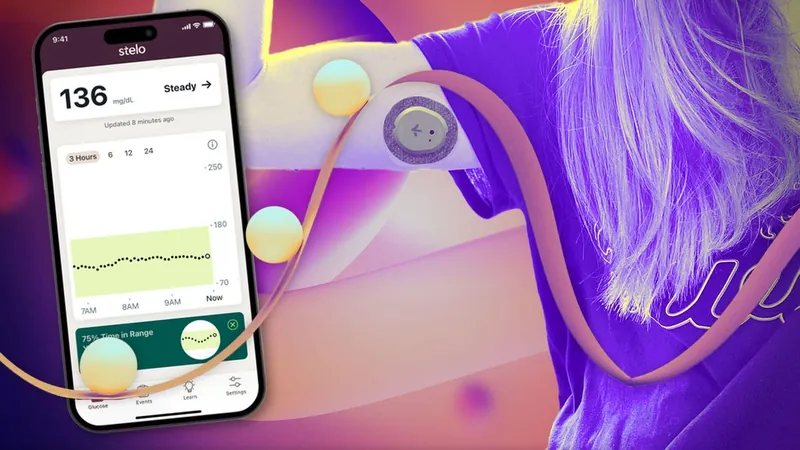
My Month-Long Blood Sugar Journey: Surprising Insights on Health and Habits
2024-09-25
Breaking the Misconceptions: Blood Sugar Isn’t Just for Diabetics
Until recently, continuous glucose monitoring (CGM) devices were primarily utilized by individuals with diabetes. However, the emergence of products like Stelo allows anyone interested in understanding their blood glucose variations to access this important information without needing a prescription. I eagerly attached the small biosensor to my upper arm, casually believing that my prior health tracking and generally good lab results would keep my levels in check.
However, this journey quickly turned into an emotional roller coaster, highlighting the complexities of managing blood sugar levels. I discovered that glucose readings can drastically fluctuate based on various factors, including sleep, stress, physical activity, and dietary choices—elements I'd never fully appreciated until their direct impact was laid bare by the CGM.
The Operation and Initial Trials: Getting the Hang of Glucose Tracking
The Stelo sensor was extremely user-friendly. After downloading the compatible app on my smartphone and creating an account, I easily attached the biosensor to the back of my arm, which monitored my blood glucose levels through interstitial fluid rather than drawing actual blood.
However, the most challenging part was logging my food intake. I quickly realized how annoying—and often impractical—it is to log every carb count. I found it easier to note general meal descriptions rather than get lost in the minutiae, as I initially though. Despite my reluctance, the app's “events” feature proved beneficial for recognizing patterns correlating with certain foods and stress levels.
Surprises Around Food Choices: When 'Healthy' Isn’t So Healthy
The most shocking encounters came from meals I assumed were healthy. A nutrient-packed salad, for instance, spiked my glucose levels unexpectedly. I was demoralized to find that processed elements like croutons or sugar-laden salad dressing could drastically alter my readings. I even experienced a staggering spike after indulging in some beloved bagels post-workout—no surprise given their high carb content, but still alarming to see on a graph.
Conversely, I learned that my two glasses of red wine and popcorn did little to raise my blood sugar levels, as alcohol can often lower glucose. It became evident that not all “bad” foods necessarily wreak havoc on my blood sugar, while consuming ostensibly healthy options might have the opposite effect.
Tracking Progress: A Shift in Trends
As I navigated through the month, my glucose readings became more stable, indicating a gradual trend toward healthier levels. By intentionally incorporating more protein into my snacks and meals, and committing to short walks post-eating, I noticed marked improvement in both my mood and glucose control over time. Interestingly, I also felt less stress during more relaxed moments spent with family, which could have played a significant role in stabilizing my blood sugar.
Expert Insights: What the Research Says
Conversations with health experts revealed that the target glucose levels for those without diabetes are indeed nuanced. While the accepted benchmark is to maintain levels below 140 mg/dL, spikes are normal and indicative of how different foods affect everyone uniquely. Dr. Isaacs, an endocrinologist, reassured me that occasional spikes post-meals are typical and not necessarily indicative of insulin resistance or future health issues.
Reflections on Health: The Bigger Picture
Throughout this month-long experiment, I recognized underlying unhealthy habits I had overlooked, such as chronic sleep deprivation. Despite believing that I managed well without consistently good sleep, research shows a clear connection between poor sleep habits and potential long-term health risks, including insulin resistance.
Ultimately, my experience with the Stelo monitor provided invaluable insights into my body's unique responses to various stimuli. While some aspects are still uncertain regarding the broader implications of continuous glucose monitoring for general health, my journey illuminated the fact that small changes in diet and lifestyle can yield significant benefits.
It reaffirmed that maintaining agency over one’s health can have a compounding effect—what starts as awareness can evolve into a proactive approach toward overall wellness. As I move forward, I am determined to prioritize healthier habits, including better sleep hygiene and consistent meal planning, all while enjoying the balance of treating myself occasionally.









 Brasil (PT)
Brasil (PT)
 Canada (EN)
Canada (EN)
 Chile (ES)
Chile (ES)
 España (ES)
España (ES)
 France (FR)
France (FR)
 Hong Kong (EN)
Hong Kong (EN)
 Italia (IT)
Italia (IT)
 日本 (JA)
日本 (JA)
 Magyarország (HU)
Magyarország (HU)
 Norge (NO)
Norge (NO)
 Polska (PL)
Polska (PL)
 Schweiz (DE)
Schweiz (DE)
 Singapore (EN)
Singapore (EN)
 Sverige (SV)
Sverige (SV)
 Suomi (FI)
Suomi (FI)
 Türkiye (TR)
Türkiye (TR)